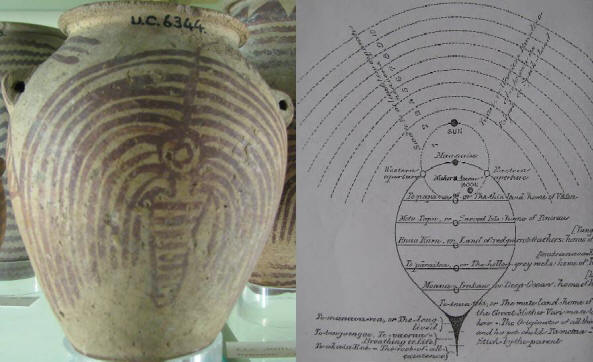
home •
about •
essential guide •
picture of the day •
thunderblogs •
news •
multimedia •
predictions •
products •
get involved •
contact
picture of the day archive subject index
Left: A pot from the Naqada II period, Egypt.
Right: A cosmic diagram from Mangaia, Polynesia, published in 1876.
Apr 17, 2008
A Potted View of Ancient Geometric Imagery
Pottery from the classical world is replete with mythological imagery, so much so that classicists treat the familiar images on black and red Attic ware as a respectable class of “witnesses” to myths otherwise known from texts.Since the onset of human history, creative artisans have decorated pots and vases with whatever occupied their minds. In some cases, pictures found on vases represent traditions not attested in any of the texts at our disposal and even these are taken into account by scholars as respectable sources.
Much the same is true for other societies as well as, presumably, the abundant pictures found on prehistoric pots, where the accompanying myths themselves can no longer be retrieved. “Abstract” or “geometric” patterns are particularly common on pottery from the Neolithic period and the Bronze Age. While circles, spirals, crosses and the like will often not have had any deeper meaning than a purely decorative fantasy of the painter, such forms may in some cases represent phenomena featured in the artist’s mythological and cosmological worldview. For example, even today cross-shaped patterns are in countless cultures linked to the four cardinal directions.
One reason to believe that many “abstract” patterns on prehistoric pots denoted cosmological concepts are the striking similarities found between these shapes and recurrent traits of ancient cosmological thought systems. An example of the often close linkage is shown above. The curious image on the left adorns a vase from the Naqada II period of prehistoric Egypt, dated to 3500-3200 BCE. The image on the right is a 19th century drawing of the cosmos as perceived by the indigenous people of Mangaia, one of the Cook Islands in southern Polynesia.
The visiting missionary-cum-anthropologist William Wyatt Gill explained that the Mangaians associated the nine concentric arcs with ten layered heavens and the segmented “balloon” below it with an “underworld” called Avaiki, comprising the “root of all existence” at the very bottom, a series of six superimposed internal divisions in the middle, and the surface of the earth at the top.
The visual similarity between these two images is striking. Is it conceivable that the Egyptian painter responsible for the adornment of the Naqada II vase was inspired by a comparable “cosmogram”, on a par with the “cosmic drums”, mandalas and mappae mundi of later ages?
The idea may not seem quite so potty if both images ultimately traced to a complex configuration once seen in the sky. Plasma physicist Dr. Anthony Peratt has recently been modeling a high-energy-density aurora that must have been observed towards the end of the Neolithic Period coming in from a south polar direction. Laboratory experiments and computer simulations bear out that this aurora, arguably recorded in millions of “geometric” petroglyphs worldwide, during one of its stages displayed a morphology quite like the images reproduced above.
Interdisciplinary collaboration also suggests that the formative history of this aurora encapsulates what traditional societies across the globe collectively remember as the ‘events of creation’. It looks like these people interpreted the complex movements and arrangements of conspicuous plasma filaments in the sky as the organization of space by mythical gods and ancestors. Strings of bead-shaped plasmoids of varying sizes gave rise to countless variations on the themes of stacked heavens, hells, and ancestors or cosmic “eggs” and “coconuts” from which the world emerged in illo tempore.
The interpretation of the image on the Naqada vase in terms of a prehistoric super-aurora may jar with archaeologists in the absence of any positive evidence for the meaning of the picture – and rightly so. Yet, on a speculative level, the analogy with similar cosmological and mythical imagery on human artifacts worldwide inspires confidence that the prehistoric painter was engaged in more than idle doodling.
Contributed by Rens Van der Sluijs
Further Reading:
The Mythology of the World Axis; Exploring the Role of Plasma in World Mythology
www.lulu.com/content/1085275The World Axis as an Atmospheric Phenomenon
www.lulu.com/content/1305081
___________________________________________________________________________Please visit our Forum
The Electric Sky and The Electric Universe available now!

|
|

|
EXECUTIVE EDITORS:
David Talbott, Wallace Thornhill
MANAGING EDITORS:
Steve Smith, Mel Acheson
CONTRIBUTING EDITORS: Michael Armstrong, Dwardu Cardona,
Ev Cochrane,
C.J. Ransom, Don Scott, Rens van der Sluijs, Ian Tresman
WEBMASTER: Brian Talbott
Copyright 2007: thunderbolts.info
![]()
home •
thunderblogs •
forum •
picture of the day •
resources •
team •
updates •
contact us

